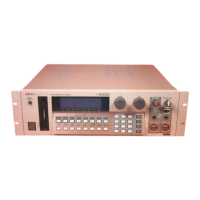Disk operations
PARK is a very important operation if you have a hard disk fitted, and should be performed
every time you end a session with a S1000 with a hard disk fitted. If you do not have a hard disk
fitted, this does not apply to you. The PARK procedure makes the hard disk safe for
transportation. If you neglect to do this, you stand the chance of losing the data on the hard disk
and
the hard disk itself if the S1000 is roughly handled. Press PARK . If, for some reason, the
heads on the hard disk are not parked properly, a message will tell you to try again. If you keep
retrying and this message continues to appear, contact your AKAI dealer. Head parking is not a
luxury - it is a necessity if you intend moving your S1000.
FORM
Before you can use a diskette, it must be formatted. MF2DD disks should be formatted as
low-density, and MF2HD disks should be formatted as high-density. As explained earlier in
this manual, these different types of diskette can be formatted in the other way, but it is not
recommended that you do this.
Formatting a diskette will permanently remove all data previously recorded on it. Only
format new diskettes or ones which contain data that you are sure you don't need any more.
Insert the diskette in the drive, select "FLOPPY" at the top of the screen, and press
HIGH or LOW , depending on the density of the diskette to be formatted. The process will take
about a minute, and the track and side number of the diskette will be displayed as the
operation proceeds.
Hard disks can and should also be formatted before use. The maximum size of hard disk
which can now be formatted and used with the S1000 is 510Mbytes (the largest size which
could be recognized under previous versions of the S1000 operating system was 60Mbytes).
If any larger hard disk is attached to the S1000, data above this size will not be recognized or
used. For convenience, large hard disks should be split into partitions, which are named A,
B, C, etc (if you are used to MS-DOS systems, these partitions are analogous to "logical
drives" on a hard disk). All partitions must be the same size, which you can select with the
"HARD PARTITIONS size" parameter to be 30, 40, 50 or 60Mbytes. The last partition on a
hard disk takes up all the remaining space on the disk (eg on a 120Mbyte disk divided into
50Mb partitions, A and B will both be 50Mbytes, and C will be 20Mbytes). However, note
the following partition sizes for the AKAI-supplied hard disks (40 and 80Mbytes), and other
disks of the same size, when they are divided into two or three partitions. Sizes are given in
blocks, where one block is 8kbytes.
Page 75
Version 2.0 89/11

